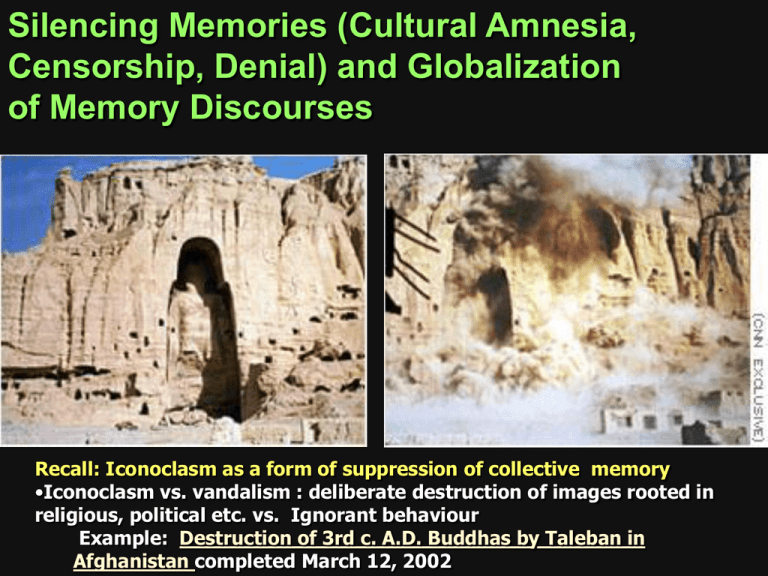11Silencing&theFutureCMNS487
advertisement

Silencing Memories (Cultural Amnesia, Censorship, Denial) and Globalization of Memory Discourses Recall: Iconoclasm as a form of suppression of collective memory •Iconoclasm vs. vandalism : deliberate destruction of images rooted in religious, political etc. vs. Ignorant behaviour Example: Destruction of 3rd c. A.D. Buddhas by Taleban in Afghanistan completed March 12, 2002 Recommended readings Trouillot, Michel-Rolph. Silencing the Past. Power and the Production of History. Boston: Beacon Press, 1995. Post, Robert (ed.). Censorship and Silencing. Practices of Cultural Regulation. Santa Monica: Getty Research Institute. 1998. Eyerman, Ron. Cultural Trauma… Cambridge U. Press 2001. Gross, David. Lost Time. Boston: U. Mass. Press 2000. Historical changes in attitudes to Memory (Gross) Ancient World – Real or mythical origins – rituals as commemoration or memory work – Forgetting as transgression Objectives – Situate self and society with respect to others – Establish legitimacy through continuity with past Memory in Medieval European traditions & Modern World Memory was “christianized” in medieval time – Old traditions and rituals still present but meanings changed (ex. Christmas replaced winter festivals) – But societies still looked to the past Modernity – emphasized the “new” – Focus on rationalism – Notion of “progress” (every new society or situation an improvement) – Industrial revolution– fractured mnemonic communities Postmodernism & globalization of memory discourses Heiddiger – forgetting as soon as possible Awareness of mediation processes that frame and change depictions of the past Confusion regarding desirability of remembering or forgetting Reframing traumatic memories to change the present and the future…. Collective Memory and Cultural Trauma Discourse Mental capacity to retrieve information and performed learned mental operations Content of recollections Location of where recollections are stored Memory in the process of identity-formation Past becomes present through embodied discourse & behaviour Collective memory of trauma as form of Public commemoration Creation of social solidarity Shared understandings provide cognitive map to orient individuals Defines temporal map unifying group in time and space, distinguising between past, present and future Collective representations of cultural trauma & Identityformation (Eyerman) Difference between individual & collective experiences of trauma – Not psychological or physical trauma of individuals but loss of identity & meaning of group that has some social cohesion Uses of remembrance to – form a new group identity – Establish solidarity amongst people with different experiences and feelings Definitions of cultural trauma (Smelzer) Memory accepted by members of a group Evokes an event of situation – Laden with negative affect – Indelible – Threatening existence or violating fundamental cultural presuppoisition of a society Trauma links past to present through mediation processes that negotiate accepted interpretations of the past & imaginative reconstruction Mediation processes Memories not only through direct experience Mediated experience, involving selective construction & representation (ex. Spike Lee’s When the Levees Broke) Mediators as “public intellectuals” who negotiate between the cultural & political spheres articulating ideas to and for others Mediation as “translation” between different groups Remembrance & Forgetting: History & Power (Trouillot) Power & invisibility “the ultimate mark of power may be its invisibility” Distinctions between what happened and what was said to have happened Interplay between historical process & our knowledge of it Fundamental ambiguity but power of historical accounts to produce, classify, construct… Cultural trauma discourse What is the purpose of does communicating about cultural trauma? – Reconfigure collective identity – Articulate the foundations for “new identities” Political, psychological, social agendas – Openness to new forms and attempt to leave other mnemonic conventions behind – Arrive at consensus about the meaning of traumatic situations through narrations Fiction vs. Fact in Collective Memory Narratives about Cultural Trauma Credibility: cultural differences in attitudes towards fictional narratives & fact Realist vs. constructivist approaches to assessing authenticity Contextual factors in legitimation of narrator’s perspective – structural position of narrator(s) socio-cultural, economic, political, ideological etc… – Role (insider or member vs. outsider or nonmember etc.) Examples African American efforts to rework collective memory through rethinking remembrance of slavery – Slavery traumatic but in retrospect – Potential to unite African Americans in the US whether or no they had any knowledge or feeling for Africa Case studies for short reports— Remembrance & making sure history not repeated;’: Nanjing massacre, Pearl Harbour, Salvadorian civil war etc… Passage from Trouillot— silencing the past Censorship & Silencing (Post) Post maintians that censorship is everywhere Different motivations for silencing the past depending on the case & perspective of the narrator Importance of understanding context of recollection or silencing Censorship rights of Aboriginal peoples as challenges to Western liberal thought Second Short Report Presentations (continued) Second Part of Class: More Discussion of Term Assignment Handout 4 Primary & secondary sources Class Presentation Dates for Term Assignment (will be split in two groups)







